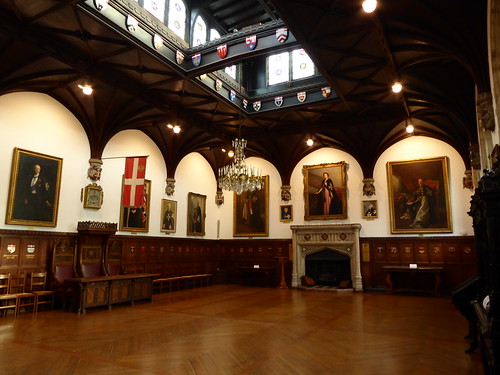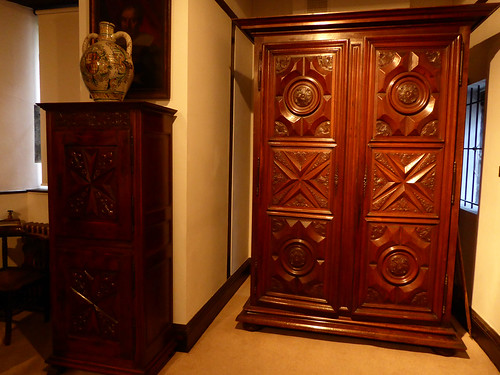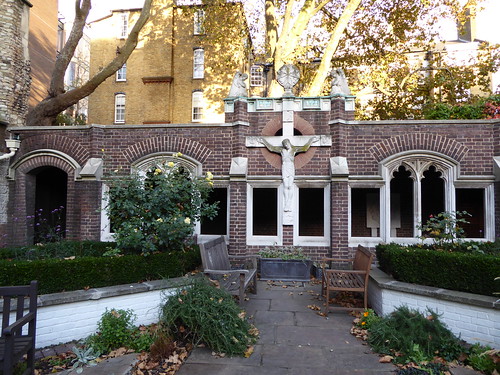The museum of the Order of St John is housed within St John’s Gate, Clerkenwell. An entrance door with the gate leads to the reception gallery where you can pick up a guidebook or leaflet providing information about the galleries. The next room is the link gallery which is designed in such a way to show off the architectural features of St John’s gate and link three themes explored in the galleries; the origins of the order, the history of the Order’s Clerkenwell Priory and the history and work of the modern Order and St John Ambulance globally.
The Order gallery tells the story of the Hospitallers from the late 11th century to the end of the 18th century, detailing their time in the Holy Land, Rhodes and Malta. The exhibition also shows the establishment of the Hospital of St John by Gerard who was the first Master of the Hospital. The Hospital was established to care for the sick and poor of all religious denominations. The hospital also took care of pilgrims who had made the long and difficult journey to the holy city of Jerusalem.
The Hospitallers were unarmed physicians, dedicated to treating those who were sick. However, over time it became necessary for them to bear arms in order to protect themselves. This led to them becoming the Knights Hospitallers, a military order similar to the Knights Templar but still primarily committed to healthcare. The Knights Hospitaller were also known as the Knights of St John and, after their expulsion from Malta they relinquished their arms and reverted solely to caring for the sick. This led to the founding of the charity, the St John Ambulance.
The St John Gallery covers more recent history and illustrates the development of the Order’s charitable work around the world. The exhibition also details the the trials the Order encountered due to religious oppression before finally becoming established as a charitable organisation with no religious affiliations, now known as St John Ambulance.
In addition to the viewing galleries we elected to go on the guided tour which I thoroughly recommend. The tour allows access to some of the private rooms within St John’s Gate and also the Priory Church and Crypt. The tour starts of in the gothic style chapter hall which is embellished with coats-of-arms of the Priors of England and heraldry of Knights of the Order both on the walls and the window glass. There are some fine portraits on the walls including one of Queen Elizabeth II who is the Order’s Sovereign Head.
A few steps lead down into the Old Chancery which houses the museum’s silver collection. The silver serves as a reminder that the Hospitallers served patients from silverware, to show their belief that the sick and the poor deserved the best possible treatment. Silver is now known for its antibacterial properties. A door leading off from the Old Chancery leads to the room over the archway of St John’s gate; the council chamber with its panelled walls adorned with gilded plaques commemorating Royal and other members of the Order who made significant contributions to charitable work.
Stepping out from the Council Chamber we descended the west tower on a rare example of an English Tudor spiral staircase made of solid oak blocks. Part way down the stairs we visited the Malta Room which houses rare 17th and 18th century paintings depicting the isle of Malta and some fine examples of Maltese furniture. After our visit to the Malta room we descended to the bottom of the Tudor staircase and emerged through a door on the opposite side of St John’s arch to where we had originally entered.
We then walked a short distance to the Priory Church. The outline of the 12th century church is marked by cobbles in St John’s square. The 18th century Priory Church was destroyed by bombs in 1941 during WWII. It was subsequently restored by the Order of St John, the current church building is the shell of the Hospitallers’ church chancel. Below the church is the crypt which dates to the 12th century and is one of London’s few remaining Norman structures This has also been lovingly restored and houses some interesting features.
Next to the church is a Cloister Garden which is a remembrance garden for members of the Order and St John Ambulance killed in both World Wars . It is planted with medicinal herbs, including St John’s Wort which is a notable cure and treatment for many wounds and ailments.
A virtual tour of St John’s Gate can be viewed here.
Sources: The guidebook of the Museum of the Order of Malta and our tour guide for the afternoon













A nice visit to Museum would be great mostly for us in the United States now.
The world is currently in a state of flux.
I always look at the places you visit, Cherry, and think about where I want to go next. Soon I will process the photos I took at Wells Cathedral and the Bishop’s Palace in September. Sometimes I DO cover your tracks.
I look forward to seeing your photos of Wells
It would be nice to meet up with you and cover some of ‘my’ tracks together
that is an excellent post, CP. i like the rows of the coat of arms.
Thank you I would have liked more time to explore the coats of arms
I would have liked more time to explore the coats of arms 
Such an interesting post with great photos. We have an area I visit near us at Temple Balsall which was once a Knights Templar base and then was taken over by the Knights Hospitallers so I found it doubly interesting to read of your visit to the museum and church.
I have just looked up Temple Balsall, it has an interesting history.
The museum and church are well worth a visit.